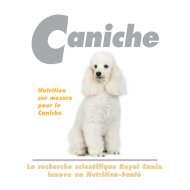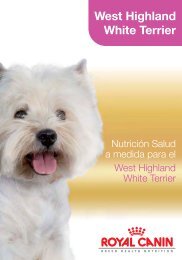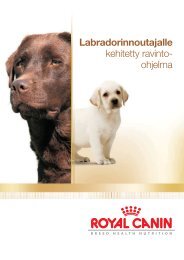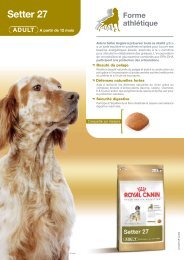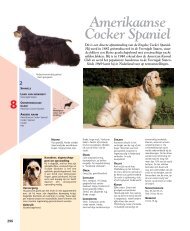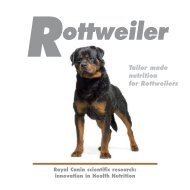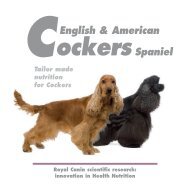The Great Dane - Breed Nutrition - Royal Canin
The Great Dane - Breed Nutrition - Royal Canin
The Great Dane - Breed Nutrition - Royal Canin
You also want an ePaper? Increase the reach of your titles
YUMPU automatically turns print PDFs into web optimized ePapers that Google loves.
Synovial fluid<br />
Synovial membrane<br />
Cartilage<br />
Structure of a joint<br />
<strong>The</strong> joint is protected by a capsule lined by<br />
the synovial membrane. This membrane secretes<br />
the fluid necessary for nutrition of the cartilage.<br />
After oral administration, glucosamine<br />
and chondroitin concentrate in the synovial fluid.<br />
<strong>Nutrition</strong> that targets<br />
the joints<br />
<strong>Nutrition</strong> provides substances that are vital to maintain joint health<br />
and activity levels. Such as chondroitin and glucoamine, which<br />
play an important role in the hydration and regeneration of cartilage,<br />
and omega-3 long chain fatty acids.<br />
Glucosamine + chondroitin sulphate:<br />
a synergistic association to protect<br />
cartilage health<br />
<strong>The</strong>se molecules belong to the family of glycosaminoglycans<br />
(GAGs), natural components of cartilage. GAGs facilitate cartilage<br />
hydration, which helps it play its role as a shock absorber.<br />
<strong>The</strong>y are also found in synovial fluid, which helps lubricate the<br />
joints. Oral administration of glucosamine and chondroitin to<br />
arthritic dogs helps to improve joint mobility (Canapp et al, 1999;<br />
Johnston et al, 2001).<br />
Glucosamine is a precursor in the synthesis of many cartilage constituents. After oral administration<br />
it is concentrated in the joints (Davidson et al, 2000) where it stimulates the production of<br />
GAGs.<br />
In humans the first results are seen after 4-8 weeks intake (Pavelka et al, 2002; Braham et al,<br />
2003).<br />
Chondroitin sulphate tends to inhibit the enzymes responsible for cartilage degradation<br />
(Basleer et al, 1998). Like glucosamine, it concentrates in the synovial fluid and the cartilage after<br />
oral administration (Conte et al, 1995; McLaughlin 2000). Daily administration produces a cumulative<br />
effect (Adebowale et al, 2002).<br />
In vitro, the synthesis of inflammatory mediators is curbed by omega 3 long-chain polyunsaturated<br />
fatty acids (EPA and DHA), which are found in concentrated form in fish oils<br />
(Curtis et al, 2002). In canine patients with arthritis of the elbow, an increased intake of omega 3<br />
fatty acids helps reduce inflammation (Hazewinkel et al, 1998).<br />
Taurine and L-carnitine:<br />
nutrients for heart function<br />
Encouraging good heart contractility with taurine<br />
Taurine is an amino acid normally synthesised by the dog from methionine and cystine, although<br />
this process appears to be less efficient in some breeds.<br />
Taurine represents at least 40% of all free amino acids in the heart. It is essential to preserve the<br />
integrity of heart muscle cells. Cases of dilated cardiomyopathy in dogs have been associated with<br />
extremely low plasma taurine levels (Alroy et al, 2000).<br />
Facilitating the supply of energy to the myocardium<br />
with L-carnitine<br />
L-carnitine is a substance that behaves like a vitamin and is found in concentrated form in the heart.<br />
An L-carnitine deficiency in the myocardium may accompany DCM (Pierpont et al, 1993).<br />
Whatever the cause or consequence of DCM, an L-carnitine deficiency should be prevented in atrisk<br />
breeds like the <strong>Great</strong> <strong>Dane</strong>. <strong>The</strong> clinical benefits of supplementation have already been proven,<br />
although several months of treatment are needed before marked improvements are observed<br />
on echocardiographs (ECG) (Keene et al, 1991).<br />
Combination of ECG results<br />
and taurine concentrations in total blood<br />
(average nmol/mL ± standard deviation)<br />
24 25<br />
Average < 200 nmol/mL < 130 nmol/mL<br />
Normal dogs (n = 49) 247 ± 73 7 3<br />
DCM dogs (n = 11) 184 ± 62 3 4<br />
<strong>The</strong> taurine levels are significantly lower in DCM dogs than they are in normal dogs (ANOVA p = 0.02).<br />
A blood taurine concentration lower than 200 nmol/mL is considered to be low. If the level is lower than<br />
130 nmol/mL, the value is considered to be very low.



